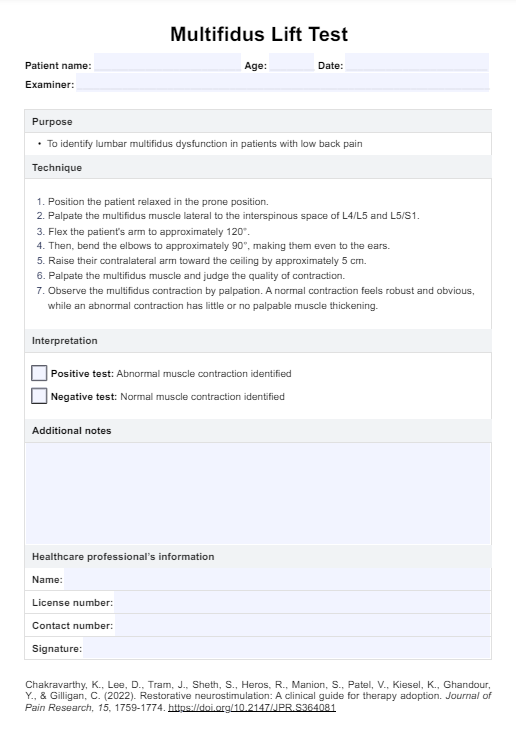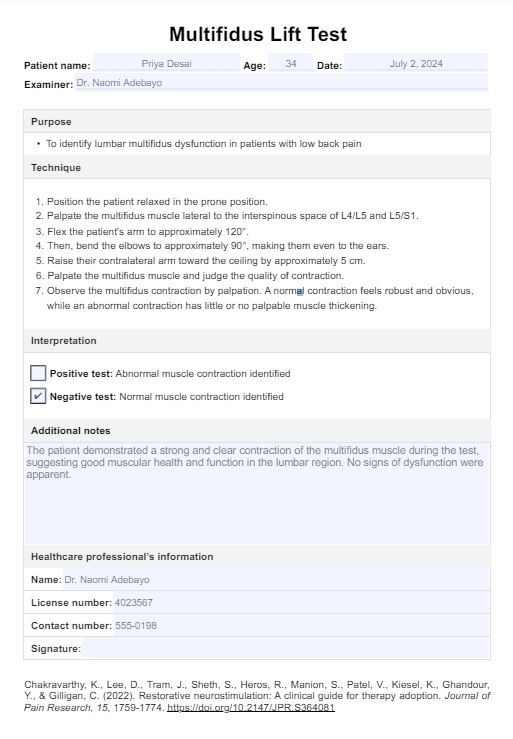Multifidus Lift Test
Explore the Multifidus Lift Test for diagnosing lumbar multifidus dysfunction, including a free PDF guide with examples and detailed steps.


What is lumbar multifidus muscle dysfunction?
Lumbar multifidus muscle dysfunction refers to issues arising in the multifidus and lumbar muscles, which are crucial for stabilizing the vertebrae along the spine. This dysfunction often manifests in reduced muscle function and pain in the lower back. It can be triggered by acute injuries, such as sudden movement or lifting heavy objects, or chronic conditions, including poor posture or degenerative disc disease.
Lumbar multifidus muscle dysfunction symptoms include localized pain, muscle stiffness, and a reduced range of motion in the lower back. Patients might have pain, and experience increased discomfort when engaging in activities that strain the lower back. This dysfunction is most commonly diagnosed in individuals who engage in physically demanding jobs, athletes, older adults, and those with a history of back injuries or conditions.
How to identify lumbar multifidus dysfunction
Identifying lumbar multifidus dysfunction typically involves clinical examination and specific testing. One critical test used is the Multifidus Lift Test, which assesses the strength and activation of the lumbar multifidus muscles during back movements. During this test, patients lie face down, and the practitioner palpates the muscles near the spine as the patient attempts to lift the affected limb or extend the back. A failure to properly activate these muscles indicates dysfunction.
Additionally, imaging tests such as magnetic resonance imaging (MRI) can be utilized to observe the multifidus muscles' structure and condition, helping to confirm a diagnosis. Physical therapists also look for signs of asymmetry in muscle size or strength and abnormal muscle contraction between the two sides of the body, which often accompanies this dysfunction.
Multifidus Lift Test Template
Multifidus Lift Test Example
What is the Multifidus Lift Test?
The Multifidus Lift Test is a clinical evaluation used to assess the function and strength of the multifidus muscles, which are vital for spinal stability. During the test, a patient lies face down. The examiner flexes the patient's arm to approximately 120°, then bends the elbows to approximately 90°, making them even with the ears. The contralateral arm is raised toward the ceiling by approximately 5 cm. Then, the examiner palpates the multifidus muscles near the lumbar spine stability. The patient then lifts an arm or a leg or extends the spine while the practitioner feels for muscle activation.
Inadequate muscle movement or strength during this activity can indicate dysfunction or weakness in the multifidus muscles. This test helps healthcare providers diagnose lumbar multifidus muscle dysfunction and tailor appropriate treatment plans.
Results and interpretations of the Multifidus Lift Test
The results of the Multifidus Lift Test are primarily used to assess the activation and strength of the multifidus muscles along the spine. Positive test results indicate healthy activation of these muscles, demonstrating proper spinal stability and function. Patients who can adequately activate their multifidus muscles typically experience less back pain and are at a lower risk of spinal injuries.
On the other hand, negative results, characterized by a lack of muscle activation, obvious muscle contraction, or strength during the test, suggest multifidus muscle dysfunction. This can manifest as an inability to perform the lift or a marked asymmetry in muscle activation between the sides of the body. Such findings are indicative of weakened spinal support, which can contribute to chronic lower back pain and a higher susceptibility to further spinal issues.
Interpreting these results allows healthcare professionals to diagnose potential problems accurately and develop a targeted rehabilitation program. Treatments may include specific exercises to strengthen the multifidus muscles, improve posture, and enhance overall spinal health, thereby reducing symptoms of leg pain and improving function.
Benefits of using our template
Our MLT template is designed to streamline the process of diagnosing lumbar multifidus dysfunction, particularly in patients with chronic low back pain. By standardizing the test procedure, our template ensures that the examination is conducted consistently and accurately across different practitioners, enhancing the reliability of the results.
The benefits of using this template include its detailed step-by-step instructions, which minimize the likelihood of procedural errors. The template ensures that each test is performed precisely by clearly outlining the patient's position, muscle palpation points, and specific movements. This consistency is crucial for maintaining high interrater reliability, as evidenced by a Kappa value between 0.75 and 0.81 indicates substantial agreement among evaluators.
Furthermore, the template demonstrates concurrent validity with ultrasound imaging at the L4/L5 level, with correlation coefficients ranging from 0.59 to 0.73. This suggests that the MLT, as guided by our template, accurately reflects musculoskeletal changes detectable by advanced imaging techniques, although it may have limitations at the L5/S1 level.
Commonly asked questions
Depending on the severity of the dysfunction, improvements can typically be noticed within a few weeks of consistent treatment.
The test is generally safe when performed by a qualified professional, though incorrect execution could potentially aggravate existing conditions.
While it can be effectively managed and symptoms significantly reduced, ongoing management is often necessary to prevent recurrence.






















-template.jpg)
















































































